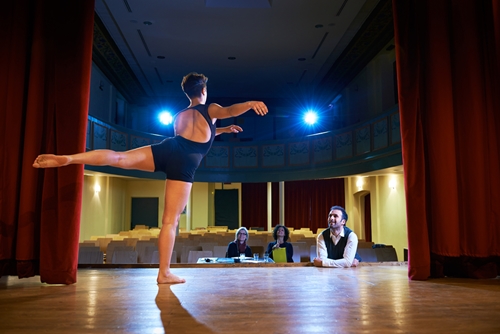You’ve finally narrowed down the list of schools you’re going to apply to, and have been daydreaming about life after graduation and all the excitement that comes with growing and maturing as a dancer in a college program. Big things are on their way! But first, you have to get through the college dance audition process. The pressure is tough and the competition can seem intense, but there’s a better way to think about auditions. They’re a chance for your unique personality to shine and for you to get a better sense of whether the school is the right fit for you.
A typical college dance audition begin with a ballet class and is followed by solo performances, improvised performances, classes in other styles like jazz and contemporary and even an interview process. While nervousness is natural, don’t let your anxiety get in the way of showcasing all you have to offer as a dancer. Extensive research and preparation and a positive attitude are key to making the best impression and helping you stand-out from the rest of the pack.
Follow our tips below to perfect your college dance audition.
Do Your Homework
Every college dance program is unique, and judges want to see that you’re a good fit for their program. Spend time in the weeks leading up to your audition learning all you can about the college and its program, the types of courses it offers, the styles of dance it performs and its values and mission. Think about how you can contribute to the program, and which of your personal and dance qualities line up with its values. Having these kinds of answers ready will prove useful in the interview phase.
Once you register for the audition, you will receive a packet detailing the schedule and specific requirements of the audition and what will be expected of you. Pay attention to this document and refer back to it frequently, noting the requirements for your clothing, costumes, makeup and shoes, and whether you need to bring photographs of yourself, an audition tape or a dance resume. If you have a better idea of what to expect you will feel more confident, and following the requirements carefully shows you pay attention to the details, which is a quality of any great dancer.
Devote Time to Preparing Your Solo
The solo performance is usually only 90 seconds long. In this short time you have to show the judges who you are as a dancer, which can be overwhelming! To make sure you’re truly showcasing all that you have to offer, prepare and practice your solo far in advance of the audition. Heather Guthrie, the dance coordinator at Southern Methodist University, told DanceSpirit Magazine that she recommends starting to practice your solo at least two months in advance.
[wpsm_video]https://www.youtube.com/embed/myF_uvUNVXk[/wpsm_video]
It’s fine to choreograph the dance yourself, or have a coach or instructor do it for you. Even if you do it yourself, make sure you’re practicing the dance in front of teachers and receiving feedback on it so you can make it the best it can be. Focus on showing your personality in the dance, and not the number of high-flying tricks you can do, since coaches want to see your spirit and style more than flashy skills. Make sure both your technical precision and presentation skills are as well-developed as they can be. And when the time comes to perform, take a deep breath, smile and go for it, knowing you’ve prepared as best you could.
Practice in Multiple Styles
A typical feature of a college dance audition is being asked to perform in a style other than your primary one, for example having to participate in a hip-hop or jazz class when you’re trained in ballet. This is because judges want to see that you’re versatile and can adapt quickly and confidently to new choreography. Prior to audition season, add a class or two in a different style to your schedule so you can get more comfortable dancing an unfamiliar genre and also get better at learning new skills and memorizing new routines quickly.
“Focus on personality in your solo dance, not your tricks.”
However, don’t drive yourself crazy trying to learn every style of dance on the planet. These tests are more to see how you dance and act in uncomfortable situations. “Our predominant technique is Graham,” said the dance chair at SMU Patty Harrington Delaney in an interview with DanceTeacher Magazine. “A lot of people have never done Graham before, and we know that. We’re looking for their openness to the direction, their attentiveness and spatial quality.”
Calm Your Nerves
Being nervous on the big day is normal, but it’s important to keep your nerves under control so they don’t impact the quality of your performance. Don’t think about all eyes being on you, but instead think about how you are talented and have prepared to the best of your ability. Remember why you dance – for the passion, the excitement and the ability to tell a powerful story through movement. Focus on the moment you are in, and not the next test or whether you are going to be accepted or not.
Follow these tips, then take a deep breath – you’ve got this!


